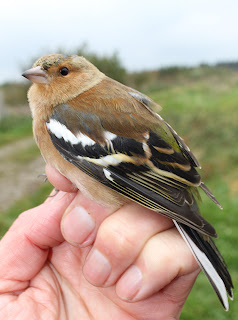It was repetition again in the form of the first birds of the morning when Grey Partridge came off the set aside to fly into the potato field, and although we doubled our previous total by seeing 4 birds, I don’t think that miserable quantity strictly counts as a covey? As we walked up the centre track of the plantation a Tawny Owl flew ahead and back into roosting cover and we didn’t see it again.
Once again we had by our standards a quite productive morning and a mixed bag with 21 new birds of 9 species and unusually, zero recaptures: 2 Whitethroat, 11 Chaffinch, 1 Willow Warbler, 2 Dunnock, 1 Great Tit, 1 Blackbird, 1 Robin, 1 Meadow Pipit and 1 Swallow.



Birds we didn’t catch this morning included a Tree Pipit sat unseen under a mist net until we approached, then later another bird that landed on the farm track and fed for a short time before it continued south. Near the top of the plantation a party of Long-tailed Tits numbering at least 15 individuals thankfully avoided our nets.
It was calm and clear all morning with nil cloud once the sun rose which didn’t help spotting any visible migration taking place, and apart from a soon-after-dawn burst of albas and Grey Wagtails heading south and the afore mentioned Tree Pipits, there was little happening. We think that our second double figure catch of Chaffinch in recent days is related to local movement, but also to the fact that a small number may be roosting in the plantation itself.
Other birds seen this morning; Jay, Kestrel, Great-spotted Woodpecker, Sparrowhawk, 3 Buzzard, Grey Heron and the Little Owl at the “horsey barn” that is so reluctant to be photographed and flies into the roof space when my car slows down. One of these days I'll catch it unawares or when it's just having a doze.


Bird watchers always like to see birds in immaculate spring plumage, but at this time of year the reality is that not only do lots of adults go through a full moult, but juvenile birds also undergo moult of their body feathers. Here’s a couple of shots of juvenile birds this week, the Blackbird we caught this morning, and a Robin in my garden this week. Give them a few days more and by early September they will look a little smarter.














































































